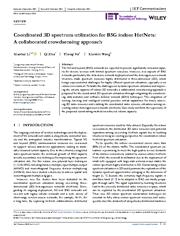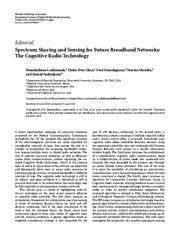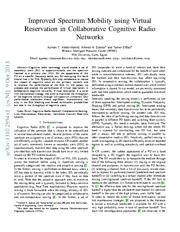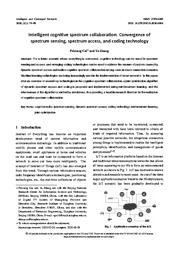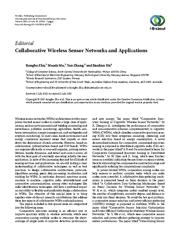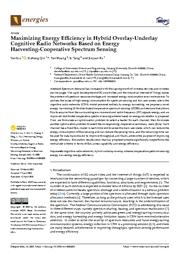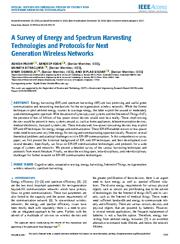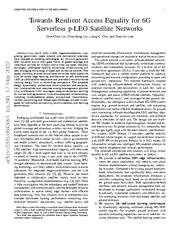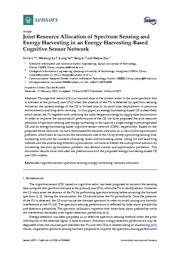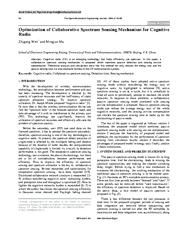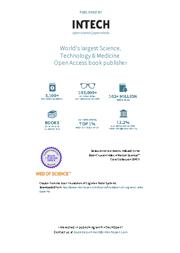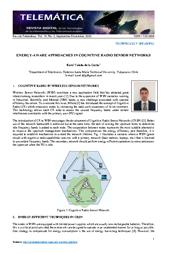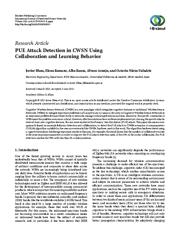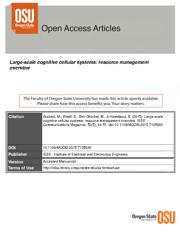A copy of this work was available on the public web and has been preserved in the Wayback Machine. The capture dates from 2022; you can also visit the original URL.
The file type is application/pdf.
Filters
Coordinated 3D spectrum utilization for B5G indoor HetNets: A collaborated crowdsensing approach
2021
IET Communications
The 5G and beyond (B5G) networks are expected to provide significantly increased capacity for diverse services with limited spectrum resources. ...
The integration of sensing, learning, and intelligent control provides critical capabilities for timely observing 3D radio resources and enabling the coordinated radio resource utilization among coexisting ...
Static spectrum sensing The limited sensing capability and intention of an individual device brings the issue that accurate full-scale observation of 3D spectrum opportunities requires the high extent ...
doi:10.1049/cmu2.12322
fatcat:c65mpmeqabesdnfn6rcxfzxwbm
Spectrum Sharing and Sensing for Future Broadband Networks: The Cognitive Radio Technology
2010
International Journal of Digital Multimedia Broadcasting
The first paper presents an optimization framework for collaborative spectrum sensing in terms of optimum decision fusion for hard and soft decision combining. ...
The fifth paper proposes an optimization technique based on genetic algorithms for optimal collaborative multiband sensing. ...
The first paper presents an optimization framework for collaborative spectrum sensing in terms of optimum decision fusion for hard and soft decision combining. ...
doi:10.1155/2010/898470
fatcat:5m4lwhwbybghnix4qjpcmljd2y
Improved spectrum mobility using virtual reservation in collaborative cognitive radio networks
2013
2013 IEEE Symposium on Computers and Communications (ISCC)
Typically, SUs may collaborate to reduce the impact of cognitive users on the primary network and to improve the performance of the SUs. ...
In this paper, we propose and analyze the performance of virtual reservation in collaborative cognitive networks. ...
SUs adopt collaborative sensing and resource allocation schemes. ...
doi:10.1109/iscc.2013.6754992
dblp:conf/iscc/Abdel-HamidZE13
fatcat:zecanecjyvgnvoiom5k3ywonu4
Intelligent cognitive spectrum collaboration: Convergence of spectrum sensing, spectrum access, and coding technology
2020
Intelligent and Converged Networks
In this paper, after an overview of several key technologies in the cognitive spectrum collaboration, a joint optimization algorithm of dynamic spectrum access and coding is proposed and implemented using ...
For a future scenario where everything is connected, cognitive technology can be used for spectrum sensing and access, and emerging coding technologies can be used to address the erasure of packets caused ...
However, a scenario where everything is interconnected generates higher demands on the use of spectrum resources, making these limited spectrum resources increasingly scarce. ...
doi:10.23919/icn.2020.0006
fatcat:662z7qhpvvdb3gu5wgaix7vbjm
Collaborative Wireless Sensor Networks and Applications
2015
International Journal of Distributed Sensor Networks
In spite of the increasing demand for all kinds of sensing services and applications, we are still lacking a clear understanding of collaborative techniques, as well as best practices, to design collaborative ...
Cooperative spectrum sensing is an efficient way to improve spectrum utility in wireless networks, which uses cooperation among multiple nodes to overcome the shortcomings of single-node to improve detection ...
And special thanks are due to the referees for their timely responses and constructive suggestions.
Rongbo Zhu Maode Ma Yan Zhang Jiankun Hu International Journal of Aerospace Engineering ...
doi:10.1155/2015/352761
fatcat:bvnw7hv2ujamxcz6j5kx5y76mi
Maximizing Energy Efficiency in Hybrid Overlay-Underlay Cognitive Radio Networks Based on Energy Harvesting-Cooperative Spectrum Sensing
2022
Energies
Spectrum demand has increased with the rapid growth of wireless devices and wireless service usage. ...
Each channel has a fixed SUs cluster in each time slot to sense the main user state, which can reduce the energy consumption of SUs sensing and can reduce the sensing time, and the remaining time can be ...
Conflicts of Interest: The author delare no conflict of interest. ...
doi:10.3390/en15082803
fatcat:oz7yx6nn7var7ivgeuenoa6hta
A Survey of Energy and Spectrum Harvesting Technologies and Protocols for Next Generation Wireless Networks
2020
IEEE Access
With the advent of cyber-physical systems and the Internet-of-Things (IoT), the presence of tens of billions of low power sensor devices would soon be a reality. ...
These EH-SH-enabled sensors or low-power nodes need to consume very little energy for sensing and communicating opportunistically. ...
A collaborative spectrum sensing with clustering of CR nodes is studied in [186] , where spectrum sensing, EH, and information transmission is studied in a time slot. ...
doi:10.1109/access.2020.3046770
fatcat:zgu7faziaje7nimeaayhjoe2yu
Collaboration and Coordination in Secondary Networks for Opportunistic Spectrum Access
[article]
2012
arXiv
pre-print
We show that collaboration among SUs can mitigate the impact of sensing errors on system performance, and improve the convergence of the learning process to the optimal solution. ...
the quality of the resources. ...
At the same time, while collaborative learning is fundamental to mitigate the impact of PU interference, coordination among SUs is required to guarantee optimal sharing of spectrum resources and to mitigate ...
arXiv:1204.3005v1
fatcat:5urhz7sjcrh5xlsaj5z7m5g3ay
Towards Resilient Access Equality for 6G Serverless p-LEO Satellite Networks
[article]
2022
arXiv
pre-print
However, convergent LEO-based satellite networking infrastructures still lack leveraging the synergy of space and terrestrial systems. ...
The proposed design dynamically orchestrates communications and computation functionalities and resources among heterogeneous physical units to efficiently fulfill multi-agent deep reinforcement learning ...
THE STATE-OF-THE-ART To integrate p-LEO or satellite swarm with ground communications, recent studies [1] - [8] focus on spectrum sensing and sharing as well as ML-based resource allocation for such ...
arXiv:2205.08430v1
fatcat:75l42xqr5zcbnat4ott22yeweq
Joint Resource Allocation of Spectrum Sensing and Energy Harvesting in an Energy-Harvesting-Based Cognitive Sensor Network
2017
Sensors
sensing time, harvesting time and the numbers of sensing nodes and harvesting nodes. ...
In order to improve the transmission performance of the CS, we have proposed the joint resource allocation of spectrum sensing and energy harvesting in the cases of a single energy-harvesting-based CS ...
Conflicts of Interest: The authors declare no conflict of interest. ...
doi:10.3390/s17030600
pmid:28300763
pmcid:PMC5375886
fatcat:r6pmlky3mzgzjnkcta3xzjw5pe
Optimization of Collaborative Spectrum Sensing Mechanism for Cognitive Radio
2014
The Open Mechanical Engineering Journal
In this paper, a collaborative spectrum sensing mechanism is proposed which combines passive detection and sensing service compensation. ...
Theoretical analysis and simulations show that this method not only reduces the energy cost and the passive sensing time, but also maintains fairness in the CR communication systems. ...
With the help of the advantages of centralized network and the flexible working of collaborative spectrum sensing, spectrum sensing time was shortened along with saving energy consumption. ...
doi:10.2174/1874155x01408010014
fatcat:2webo2db7rdjjgtktcis7y2eny
Collaborative Spectrum Sensing for Cognitive Radio Networks
[chapter]
2012
Foundation of Cognitive Radio Systems
These studies have motivated the investigation on techniques of optimizing spectrum sensing and resource allocation jointly. ...
Also, the TDC-SS algorithm can adapt itself with transition rate of PU state.
Challenges In Section (2.1), the studies of optimal trade-off between sensing time and transmission time are reviewed. ...
Since many spectra are not fully utilized most of the time, cognitive radio, as a form of spectrum reuse, can be an effective means to significantly boost communications resources. ...
doi:10.5772/32226
fatcat:qyr4yfwgmjdf3pg2bohkq2tev4
Energy-Aware Approaches in Cognitive Radio Sensor Networks
2020
Telemática
Due to the expansion of WSN scenarios running in Industrial, Scientific, and Medical (ISM) bands, a new challenge associated with spectral efficiency has arisen. ...
To overcome this issue, Mitola [2] has introduced the concept of Cognitive Radio (CR) which empowers nodes by increasing the radio unit's awareness of its environment. ...
Besides, Lin [18] deal with the process of spectrum sensing by considering the selection of the optimal number of SUs, fair competition, and efficient utilization of spectrum access. ...
doaj:ebe49abaea8f44c7a797e7016fe43c87
fatcat:xwqnzj236zaznlymtygtprvqoq
PUE Attack Detection in CWSN Using Collaboration and Learning Behavior
2013
International Journal of Distributed Sensor Networks
If the 20% of the nodes collaborates, the PUE detection reaches the 98% with less than 1% of false positives. ...
For example, the result shows that the number of collaborative nodes is the most important parameter in order to improve the PUE attack detection rates. ...
Another motivation for the collaboration is the resource limitation. Nodes of CWSN have to sleep, and their computing resources and energy are limited. ...
doi:10.1155/2013/815959
fatcat:gobppktskrcgbezkdoe2odyazq
Large-scale cognitive cellular systems: resource management overview
2015
IEEE Communications Magazine
Hence, within the same portion of the spectrum, two systems with two levels of priority can coexist; a Primary System (PS) with the highest priority to access the spectrum, and a Secondary System (SS) ...
However, various spectrum measurement studies have shown that the problem is mainly due to lack of efficiency in the spectrum utilization rather than due to scarcity of resources. ...
It is a class of optimization techniques useful for solving optimization problems with conflicting resources. ...
doi:10.1109/mcom.2015.7105640
fatcat:3cvgmbrhdrhphhkpxdyz2uqkqi
« Previous
Showing results 1 — 15 out of 76,801 results

